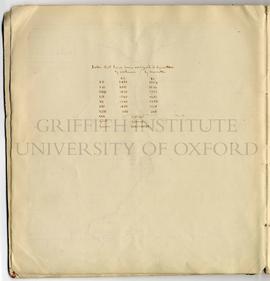Giza (Gîza). The Great Sphinx.
Note reads:
'The Sphinx is supposed to be of pyramid date from (1) a tablet of the time of Xufu which mentions it, and from (2) the dream of Thothmes IV which attributes it to Xafra. (3) also its surroundings at Gizeh, of any consequence, are of that period. But on the other hand the tablet was found in a temple of Petuxanu of 21st dynasty, and is clearly a later and altered copy (or an invention) as it contains figures of Osiris, Isis and Horus, Horus, Isis Seth, Pasht?, Khem, the human headed uraeus, and sacred bark, which are not found on the early monuments: beside which the mention of the sphinx in it is only an incidental topographical allusion, not essential to the tablet. The allusion by Thothmes IV is also not conclusive, and it is of doubtful critical value concerning a king who reigned 1000 or 2000 years earlier. The strongest positive argument for the late date of the sphinx is that no drawing of a sphinx in symbols, or hieroglyphs, & no statue, is known before the Hyksos; the black granite Hyksos sphinx in Bulak being the earliest I believe. Was it not then an Asiatic idea (see the Assyrian human-headed animals) imported by the Hyksos? To them seems due the notion of burying images of slaves with a body, none such being known before their epoch, and this being a form of the Asiatic custom of burying strangled slaves with a great funeral.'
![[363] Retaining wall of stones mud plastered](/uploads/r/null/8/2/4/82433aa9e69c5492c669db3ca2613823214270d387205e6263847eeb346fb4b1/Petrie_5_5_18_363_res600ppi_142.jpg)
![[12] Desert W. of Gt. Pyramid.](/uploads/r/null/8/c/5/8c5d3380d4d6add200966c6d612482e55ebe52fb007594d1375a07f766d4caa0/Petrie_5_5_18_012_res600ppi_142.jpg)
![[397-8] Temple and causeway of third pyramid](/uploads/r/null/9/3/4/934dd927ea12deb67b043c6688003ca507af2e9782b53ad1f5026773d0c873be/Petrie_5_5_22_397to8_res600ppi_142.jpg)
![[549] Inside of tomb in rock, E. of Great Pyramid.](/uploads/r/null/b/c/0/bc0201232e6a8ee5b8cffe8b20b0f63df69bf441c7f455cc4a33f64f4fe0ac57/Petrie_5_5_24_549_res600ppi_142.jpg)
![[550] Inside of tomb E. of pyramid.](/uploads/r/null/5/a/5/5a5eeee76688ab742872ac88c41c229440741af2e7d49785e339b8be5bc76462/Petrie_5_5_24_550_res600ppi_142.jpg)
![[390] Tomb with many air holes.](/uploads/r/null/7/3/4/734905b7289e3f640341a04d222fe0f3df25dc4460c7a24381a8e5002d8152cd/Petrie_5_5_25_390_res600ppi_142.jpg)
![[393] Tomb of Xemten, S.W. of Gt Pyramid](/uploads/r/null/4/1/4/414ba19ba6ab85178505f1a5806bd85345065bbad3024ffa13ab27e9d31f8f22/Petrie_5_5_26_393_res600ppi_142.jpg)
![[396] Block with name & titles of Xemten](/uploads/r/null/d/5/3/d53230e2b2c630a63593bfb2a0e6856fbe727ff2e90c6ccac824e18336c61a18/Petrie_5_5_26_396_res600ppi_142.jpg)
![[362] Women carrying produce from the farms of Semnefer.](/uploads/r/null/2/6/2/26214ba3946d93e81d47dcae8cc4bcbebbd7a3274f5762a7c0edcec97b99957b/Petrie_5_5_27_362_res600ppi_142.jpg)
![[336] Pet apes of the son of a king.](/uploads/r/null/5/c/3/5c360edf37ef20270ee14f93c340e52e94c7618c912b0b9b46e5bfa3c6f174a1/Petrie_5_5_28_336_res600ppi_142.jpg)
![[337] Bier or coffin, attended by two men at the foot of it.](/uploads/r/null/6/8/5/685a0b76358f7b387bded2a515cd1975847dbb41990bb0760d66070ad209786d/Petrie_5_5_28_337_res600ppi_142.jpg)
![[476] Masonry of pyramid at Sakkara](/uploads/r/null/d/d/f/ddf41e2080eff7c5ffe3c91b4b655bbf6a4868c4388cc9085de3a773528f03ca/Petrie_5_5_30_476_res600ppi_142.jpg)
![[466] North pyramid of Dahshûr.](/uploads/r/null/9/0/d/90d25b154b9df7e8c5263da3b7cccc522542bb73b677b8bbabf37425abae1b99/Petrie_5_5_31_466_res600ppi_142.jpg)
![[473] South brick pyramid of Dahshûr.](/uploads/r/null/7/4/f/74f276f086a82edae543bc79ff1290e0a843f50f752a80192cc74368d9707794/Petrie_5_5_32_473_res600ppi_142.jpg)
![[471] Small pyramid. South of S. pyramid of Dahshûr.](/uploads/r/null/0/8/1/081208fd9470b0b8100c912507f21d05cb81f4493b989f76a464845ed43dc167/Petrie_5_5_32_471_res600ppi_142.jpg)
![[472] Top of South brick pyramid, Dahshûr.](/uploads/r/null/4/c/e/4ce471ecf5dccea273ce7821b2251e5d4ebb91561ad83e30b4cac94a12fb9b9d/Petrie_5_5_32_472_res600ppi_142.jpg)
![[527] The Pyramid of Howara.](/uploads/r/null/6/3/2/632960edae739de43ae0e2137a067cb5d763eada0d0db775b653da82a8e40d84/Petrie_5_5_34_527_res600ppi_142.jpg)
![[521] Great limestone pavement in two layers.](/uploads/r/null/b/9/2/b926841ecd63b022f632bf6274377b64ce52fa73e0857a74886442d9622d214b/Petrie_5_5_34_521_res600ppi_142.jpg)
![[524] Probable site of Labyrinth.](/uploads/r/null/a/0/7/a0722ac1aabffe242138984c11ad35cd9976c84a70ea99cf6d1b0dc4ab908c2a/Petrie_5_5_35_524_res600ppi_142.jpg)
![[491] Closer view of corner of enclosure.](/uploads/r/null/4/2/3/423bfbb7cbe96112db1bddbba230210a7f582ccc78aadd0bfb7d5ba3737a9882/Petrie_5_5_36_491_res600ppi_142.jpg)
![[369] The Sphinx](/uploads/r/null/b/1/a/b1a9a245f340173628981cc0f1cb345980291c0ff46b10108a83564cc430b214/Petrie_5_5_37_46_res600ppi_142.jpg)



![[507] Obelisk of Ebgig, from East.](/uploads/r/null/3/0/2/3025b4e0c830935d15b8a20605f433797e731de796152192b2abc5b0fc20b0c6/Petrie_5_06_01_507_res600ppi_142.jpg)
![[120] Wrestlers. Tomb No 17 Beni Hassan.](/uploads/r/null/8/0/6/80631c52abe019005335238ec476c3d49beae71906a00c25935bf7d29daf6ab6/Petrie_5_06_03_120_res600ppi_142.jpg)
![[121] Wrestlers. Tomb No 15 Beni Hassan.](/uploads/r/null/e/6/c/e6c04051880578c9be88d98f354851cec9be46f7a65f3ed7ef90515693f07eb9/Petrie_5_06_03_121_res600ppi_142.jpg)
![[117] Lotus columns. Tomb No 18 Beni Hassan.](/uploads/r/null/f/d/9/fd94dc57fcdd5822839a7d9a648e735deda4bae64ee7307eee5075d93b7eb2ca/Petrie_5_06_04_117_res600ppi_142.jpg)
![[311] Part of collonade of temple. Deir el Bahari.](/uploads/r/null/4/b/3/4b3aa11dfd1ed2915709ff7a5533b7a0eef9cffdf4b940dac86137b656b4474a/Petrie_5_06_08_311_res600ppi_142.jpg)
![[190] Granite columns of Thothmes III. Karnak.](/uploads/r/null/e/f/9/ef9a43928a08dec2318606b31b3fceeebae444404902a1345ac5017c8395bf86/Petrie_5_06_08_190_res600ppi_142.jpg)